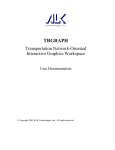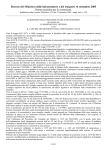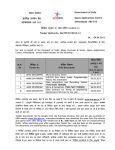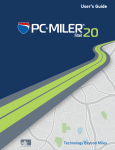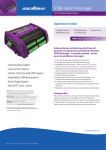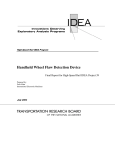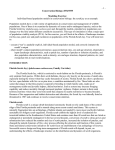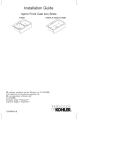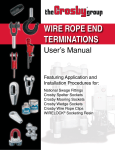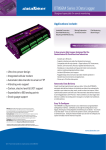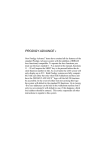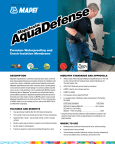Download Highway-Railway At-Grade Crossings
Transcript
Research Report KTC-09-05/FR136-04-2F KENTUCKY TRANSPORTATION CENTER HIGHWAY-RAILWAY AT-GRADE CROSSING STRUCTURES: TRACKBED AND SURFACE PRESSURE MEASUREMENTS AND ASSESSMENTS OUR MISSION We provide services to the transportation community through research, technology transfer and education. We create and participate in partnerships to promote safe and effective transportation systems. OUR VALUES Teamwork Listening and communicating along with courtesy and respect for others. Honesty and Ethical Behavior Delivering the highest quality products and services. Continuous Improvement In all that we do. Research Report KTC-09-05/FR 136-04-2F Highway-Railway At-Grade Crossings: Trackbed and Surface Pressure Measurements and Assessments By Jerry G. Rose Professor of Civil Engineering and Daniel M. Durrett, Lindsay A. Walker, Jason C. Stith Research Assistants in Civil Engineering ABSTRACT Techniques are described for installing instrumentation within highway/railway crossings – to measure vertical pressures under moving highway and railway loadings – using earth pressure cells. Also, techniques are described for installing instrumentation between rail base/tie plate interfaces – to measure vertical pressures under moving railway loadings – using pressure sensitive ink sensors. In addition, the sensors were used to measure the surface pressures imparted by highway vehicles on crossing surfaces. Data is presented for several crossings including a wide variety of conditions and loading intensities. The data serves to quantify pressure gradients within highway/railway crossings for application to structural design analyses. Keywords: Highway-Railway Crossings, Tire-Pavement Pressures, Railway Trackbed Pressures, Railway Loadings, Highway Loadings, Earth Pressure Cells, Pressure Sensitive Ink Sensors, Geokon, Tekscan May 2009 1. Report No. 2. Government Accession No. 3. Recipient’s Catalog No KTC-09-05/FR 136-04-2F 4. Title and Subtitle 5. Report Date May 2009 Highway-Railway At-Grade Crossings: Trackbed and Surface 6. Performing Organization Code Pressure Measurements and Assessments 7. Author(s) 8. Performing Organization Report No. Jerry G. Rose, Daniel M. Durrett, Lindsay A. Walker, and Jason C. Stith 9. Performing Organization Name and Address Kentucky Transportation Center College of Engineering University of Kentucky Lexington, KY 40506-0281 KTC-09-05 10. Work Unit No. (TRAIS) 11. Contract or Grant No. FRT 136 12. Sponsoring Agency Name and Address Kentucky Transportation Cabinet 200 Mero Street Frankfort, KY 4062 13. Type of Report and Period Covered Final Report – KTC -09-05 7/1/2004 – 6/30/09 14. Sponsoring Agency Code 15. Supplementary Notes Prepared in cooperation with the Kentucky Transportation Cabinet and the United States Department of Transportation, Federal Highway Administration 16. Abstract Techniques are described for installing instrumentation within highway/railway crossings – to measure vertical pressures under moving highway and railway loadings – using earth pressure cells. Also, techniques are described for installing instrumentation between rail base/tie plate interfaces – to measure vertical pressures under moving railway loadings – using pressure sensitive ink sensors. In addition, the sensors were used to measure the surface pressures imparted by highway vehicles on crossing surfaces. Data is presented for several crossings including a wide variety of conditions and loading intensities. The data serves to quantify pressure gradients within highway/railway crossings for application to structural design analyses. 17. Key Words 18. Distribution Statement Highway-Railway Crossings, Tire-Pavement Pressures, Railway Trackbed Pressures, Railway Loadings, Highway Unlimited, with the approval of the Loadings, Earth Pressure Cells, Pressure Sensitive Ink Sensors, Kentucky Transportation Cabinet Geokon, Tekscan 19. Security Classif. (of this report) Unclassified Form DOT F 1700.7 (8-72) 20. Security Classif. (of this page) Unclassified 21. No. of Pages 41 w/o appendix 22. Price TABLE OF CONTENTS Page EXECUTIVE SUMMARY ............................................................................................. 1 CHAPTER 1. INTRODUCTION .................................................................................... 2 1.1 BACKGROUND ..................................................................................................... 2 1.2 ASPHALT UNDERLAYMENT APPLICATION ....................................................... 3 1.3 SCOPE .................................................................................................................. 3 CHAPTER 2. EARTH PRESSURE CELL MEASUREMENTS .................................... 4 2.1 INTRODUCTION ................................................................................................... 4 2.2 SETUP AND DATA ACQUISITION SYSTEM ....................................................... 4 2.3 CALIBRATION ...................................................................................................... 7 2.4 INSTALLATION PROCEDURE ............................................................................. 7 2.4.1 Richmond Installation ......................................................................................... 7 2.4.2 Lackey Installation .............................................................................................. 9 2.5 TYPICAL TRAIN LOADINGS ................................................................................ 9 2.6 PRESSURE DATA FOR TRAIN LOADINGS ....................................................... 12 2.6.1 Richmond Crossing Data .................................................................................. 12 2.6.2 Lackey Crossing Data ....................................................................................... 14 2.7 TRANSPORTATION TECHNOLOGY CENTER DATA ........................................ 22 2.8 FLAT WHEEL EFFECTS ..................................................................................... 22 2.9 PRESSURE DATA FOR HIGHWAY VEHICLE LOADINGS ................................. 24 2.9.1 Highway Trucks at Lackey ................................................................................ 24 2.9.2 Highway Trucks at Richmond ............................................................................ 28 2.9.3 Passenger Cars ................................................................................................. 30 2.10 DISCUSSION ..................................................................................................... 31 CHAPTER 3. PRESSURE SENSITIVE INK SENSORS ............................................ 32 3.1 DATA ACQUISITION SYSTEM ............................................................................ 32 3.2 CALIBRATION ..................................................................................................... 32 3.3 TYPICAL PRESSURE DATA ............................................................................... 32 CHAPTER 4. FINDINGS AND CONCLUSIONS ........................................................ 38 4.1 FINDINGS ............................................................................................................ 38 4.2 CONCLUSIONS ................................................................................................... 38 REFERENCES ........................................................................................................... 40 ACKNOWLEDGEMENTS .......................................................................................... 41 APPENDIX A ............................................................................................................. A-1 APPENDIX B ............................................................................................................. B-1 APPENDIX C ............................................................................................................. C-1 ii Page List of Figures Figure 2.1 Typical Pressure Cell .................................................................................. 5 Figure 2.2 Pressure Cell Measurement Configuration .................................................. 5 Figure 2.3 Water Column for Pressure Cell Calibration ................................................ 8 Figure 2.4 Pressure Cell Installation ............................................................................. 8 Figure 2.4.1a Rehabilitated Crossing in Richmond, Kentucky ...................................... 10 Figure 2.4.1b Configuration of Pressure Cells in the Richmond Crossing .................... 10 Figure 2.4.2a Rehabilitated Crossing in Lackey, Kentucky .......................................... 11 Figure 2.4.2b Pressure Cells Placed on the Asphalt Layer .......................................... 11 Figure 2.4.2c Configuration of Pressure Cells in the Lackey Crossing ......................... 12 Figure 2.6.1a Pressures for Loaded Auto Train at Richmond ...................................... 15 Figure 2.6.1b Loaded Coal Train at Richmond ............................................................. 16 Figure 2.6.2a Pressures for Empty Coal Train at Lackey ............................................. 20 Figure 2.6.2b Pressures for Loaded Coal Train at Lackey ........................................... 21 Figure 2.8 Flat Wheels on an Empty Coal Train at Lackey .......................................... 25 Figure 2.9.1 Typical 22-Wheel Tractor-Trailer Truck .................................................... 26 Figure 2.9.2 Typical Concrete Truck ............................................................................ 29 Figure 2.9.3 Typical Pressure Trace of a Passenger Car ............................................. 31 Figure 3.1a Basic Tekscan Sensor Schematic ............................................................. 33 Figure 3.1b Schematic Diagram of Tekscan Measurement System in the Track ......... 33 Figure 3.1c Position of Tekscan Sensor During In-track Testing .................................. 34 Figure 3.3a Imprint of Tractor Rear Tire of 151,000 lb Loaded Coal Truck .................. 35 Figure 3.3b Imprint of Front Tire of 8,000 lb Suburban Truck ....................................... 36 Figure 3.3c Placement of Tekscan Sensor in Track ..................................................... 37 List of Tables Table 2.5 Typical Train Loads ...................................................................................... 14 Table 2.6.1a Pressures (psi) for Locomotives from Empty and Loaded Auto Trains at Richmond ................................................................................. 17 Table 2.6.1b Pressures (psi) for Auto Cars from Empty and Loaded Auto Trains at Richmond ................................................................................. 17 Table 2.6.1c Pressures (psi) for Locomotives from Empty Coal Trains at Richmond ................................................................................................ 17 Table 2.6.1d Pressures (psi) for Empty Hoppers from Empty Coal Trains at Richmond ................................................................................................ 18 Table 2.6.1e Pressures (psi) for Locomotives from Loaded Coal Trains at Richmond ................................................................................................ 18 Table 2.6.1f Pressures (psi) for Loaded Hoppers from Loaded Coal Trains at Richmond ................................................................................................ 18 iii Page Table 2.6.2a Pressures (psi) for Locomotives from Empty Coal Trains at Lackey ....... 23 Table 2.6.2b Pressures (psi) for Empty Hoppers from Empty Coal Trains at Lackey ..................................................................................................... 23 Table 2.6.2c Pressures (psi) for Locomotives from Loaded Coal Trains at Lackey ...... 23 Table 2.6.2d Pressures (psi) for Loaded Hoppers from Loaded Coal Trains at Lackey ..................................................................................................... 23 Table 2.9.1a Pressures (psi) for Single Axle from 22-Wheelers at Lackey ................... 27 Table 2.9.1b Pressures (psi) for Dual Axle from 22-Wheelers at Lackey ..................... 27 Table 2.9.1c Pressures (psi) for Tri-Axle from 22-Wheelers at Lackey ........................ 27 Table 2.9.1d Pressures (psi) for Single Axle from Single-Dual Axle Trucks at Lackey ..................................................................................................... 27 Table 2.9.1e Pressures (psi) for Dual Axle from Single-Dual Axle Trucks at Lackey ..................................................................................................... 28 Table 2.9.2a Pressures (psi) for Single Axle from Single-Dual Axle Trucks at Richmond ................................................................................................ 30 Table 2.9.2b Pressures (psi) for Dual Axle from Single-Dual Axle Trucks at Richmond ................................................................................................ 30 iv EXECUTIVE SUMMARY Imposed pressures at critical interfaces on the surface of highway/railway crossings and within the track structure were successfully measured using pressure sensitive ink sensors (Tekscan) and earth pressure cells (Geokon). Measurements were confined to crossings containing a definable layer of asphalt, similar to subballast, within the structure. The non-intrusive nature of the thin pressure sensitive ink sensor makes it ideal for pressure measurements within the upper region of the track structure and on the surface of the crossing. The more conventional earth pressure cell is applicable for pressure measurements at the interfaces between the identified structural layers within the track structure. Peak dynamic pressures typically ranged from 400 to 600 psi (2,800 to 4,200 kPa) at the rail base/tie plate interface for the 286,000 lb of (130 metric ton) locomotives and loaded cars. The pressures were reduced from 13 to 17 psi (90 to 120 kPa) on top of the asphalt layer for the same loading condition. This is only two to three times greater in magnitude than the pressure exerted by an average-size person standing on an asphalt pavement. The pressures were further reduced by the asphalt layer to 7 to 8 psi (50 to 55 kPa) under the asphalt layer at the subgrade interface. In-track test measurements on asphalt underlayment trackbeds obtained on the revenue lines and those obtained by TTCI’s heavy-haul research test facility are consistent for similar trackbed structural compositions. Static pressures measured with the Tekscan sensors at the tire/pavement interface on crossing surfaces indicate that the intensity of the contact pressure is similar to the measured tire inflation pressure. These values ranged from 135 psi (930 kPa) for heavily loaded trucks to 75 psi (520 kPa) for loaded utility trucks to around 30 psi (210 kPa) for typical passenger automotives. 1 CHAPTER 1. INTRODUCTION 1.1 BACKGROUND The primary purpose of the at-grade highway-railway crossing is to provide a smooth surface for the safe passage of rubber-tired vehicles across the railroad. The crossing surface and trackbed (rail, ties, and ballast/subballast) replace the highway pavement structure within the jointly used crossing area. The crossing surface represents a significantly expensive special portion of the railroad and highway systems. Crossings are likely to deteriorate at a faster rate and require reconstruction at more frequent intervals than the pavement (or railroad) adjacent to the crossing. In addition, crossings often provide a low ride quality, due to settlement soon after reconstruction, and the driving public must tolerate this annoyance until funding for reconstruction is available. The crossing structure must provide adequate structural integrity to support the imposed loadings. Typical crossing designs only provide for the crossing surface to be placed beside the rails and above the ties. Only unbound granular materials and possibly a geosynthetic are placed under the ties. The open granular trackbed permits surface water entering along the rail and the joints within the surface to penetrate and subsequently saturate the underlying subgrade/roadbed, thus lowering the structural integrity of the structure. Groundwater, if present due to inadequate drainage, further lowers the structural integrity of the trackbed support layer. Crossing structures having inadequate structural support provide excessive deflections under combined highway/railroad loadings, which increase effective impact stresses and fatigue on the crossing components. The surface deteriorates prematurely. Permanent settlement occurs within the crossing area imparting additional impact stresses and fatigue from both highway and railroad loadings. Periodically, the trackbed on both sides of the crossing will be raised with additional ballast and surfaced. The crossing becomes a permanent low spot in the railroad profile, which further increases impact stresses from the railroad loadings. In addition, the low spot serves to collect water, and the impaired drainage further weakens the underlying structure. When the roughness and deterioration of the crossing adversely affect the safety and reasonable traffic operations across the crossing, the crossing must be removed and replaced at tremendous cost and inconvenience to the traveling public and railroad operations. Typically, the crossing is replaced using similar materials and techniques, thus assuring a similar series of events. The typical crossing renewed with conventional granular materials often isn’t structurally adequate to withstand the combined highway/railroad loadings. A high-quality substructure (or base) is needed below the trackbed to provide similar load carrying, confining, and waterproofing qualities to the common crossing area as exists in the abutting pavement sections. 2 1.2 ASPHALT UNDERLAYMENT APPLICATION Many innovative practices have been utilized by the railroad industry in recent years. These provide increased efficiency so the railroad industry can achieve greater profitability and compete with other modes of transportation. Designs and materials selection for the track structure have advanced in recent years to accommodate the increased tonnages and car weights. Continuously welded rail, larger size rail, cleaner steel and premium steel for specific applications represent advances in rail technology. Various new designs and material compositions for ties and fasteners are in use and undergoing evaluations. The advantages of selecting high quality ballast materials are well documented. Hot mix asphalt has been used as a subballast layer to replace granular subballast. A substantial amount of this development research has been conducted during the past 25 years. Papers describing this development have been presented previously (Rose & Tucker, 2002) (Rose, Li, & Walker, 2002). Asphalt underlayments have shown to be particularly applicable to special track features such as railroad crossing diamonds, rail/highway crossings, tunnel floors, and bridge approaches. The underlayment is also applicable to areas of open track with weak subgrades, soft soils or poor drainage. According to the Asphalt Institute, there are multiple benefits of a hot mixed asphalt layer in a track structure including (Asphalt Institute, 1998): A strengthened track support layer below the ballast to uniformly distribute reduced loading stresses to the roadbed (subgrade); A waterproofing layer and confinement to the underlying roadbed that provides consistent load, carrying capability for track structures, even on roadbeds of marginal quality; An impermeable layer to divert water to side ditches, essentially eliminating subgrade moisture fluctuations; A consistently high level of confinement for the ballast so it can develop high shear strength and provide uniform pressure distribution; A resilient layer between the ballast and roadbed to reduce the likelihood of subgrade pumping without substantially increasing track stiffness; and An all-weather, uniformly stable surface for placing the ballast and track superstructure. 1.3 SCOPE It has been desirable for years to develop non-invasive procedures to determine the pressures/stresses at various levels and interfaces in highway/railway crossing structures. Understanding how the crossing layers respond to highway and railway dynamic loadings is an important aspect to optimize crossing designs and improve long-term performance. The research reported herein documents the development of techniques to measure pressures 1) within the crossing support layers using Geokon earth pressure cells and 2) on the crossing surface using Tekscan pressure sensitive ink sensors. The report specifically describes: The optimum procedure to install the sensors into the track, The recommended practices to effectively collect data with the software, The accepted techniques for analyzing the results, and Pressure data from highway/rail crossings containing asphalt underlayment. 3 CHAPTER 2. EARTH PRESSURE CELL MEASUREMENTS 2.1 INTRODUCTION Geokon Model 3500 Earth Pressure Cells were used to measure the pressure exerted by a train or highway vehicle on supporting materials within the track structure. Figure 2.1 is a picture of the typical hydraulic type pressure cell. The portion of the cell that receives the load consists of two flat stainless steel circular plates, 9 in. (23 cm) in diameter welded together at their periphery. The space between the two plates is filled with de-aired hydraulic fluid. When a load is applied to the plates, the load compresses the fluid and forces it down a short length of high-pressure stainless steel tubing. This tubing connects to a pressure transducer, which converts the pressure of the compressed fluid into an electrical signal. From the pressure transducer, the electrical signal is transmitted through a signal cable to the readout location. 2.2 SETUP AND DATA ACQUISITION SYSTEM A simple setup is used to record the voltages. The pressure cell is placed within the track structure at the point where measurements are to be taken. A laptop computer with data acquisition software is required to provide the readout location. The 12-volt pressure cell cannot be connected directly to the computer, so a junction box is also required. The junction box has the pressure cells connected to it, which is in turn connected to the laptop computer. A 12-volt battery provides power for the electrical signal. This battery also connects to the junction box. In this manner, the junction box acts as a hub through which all components connect, and also provides multiple ports for additional pressure cells thereby allowing for multiple pressure readings to be recorded simultaneously. Figure 2.2 is a depiction of the configuration of the components. Snap-Master was the data acquisition system used for obtaining the pressure measurements. It is a Windows-based program that allows the user to record the electrical signal from the pressure cell in real time. In order to run the program, the system requires either Windows 95 or 98 to be installed on the computer. Following are the basic steps for recording a pressure reading using Snap-Master: 1. Install the pressure cell in the desired location in the trackbed. 2. Connect the pressure cell to a 12-volt battery for power and a laptop computer with Snap-Master installed. 3. Turn on computer and wait for the main menu with the program icons to appear. Select ‘Start’ from the bottom left corner and click on ‘Programs’. This will display a list of folders that contain all of the programs. Select the folder labeled ‘HEM Data’, and then select ‘Snap-Master’. 4. Once Snap-Master is open, go to the ‘File’ tab in the upper left corner of the screen. A drop down menu will appear. Select ‘Open Instrument’ from this menu. Another menu will appear, and this time select ‘Newpress’. 5. Now the screen should display three icons running diagonally from top left to bottom right. The first icon is the A/D Device. Selecting this icon will allow the user to edit the port that the cell connects to in the junction box. For example, if only one pressure cell is in use, then it will be plugged into the first port, channel A0 in the junction box. Therefore, only the A0 line should have a ‘yes’ next to it. For every cell that connects to the junction box, the corresponding port should be labeled ‘yes’ in this 4 Figure 2.1. Typical Pressure Cell Junction Box Pressure Cell Battery Figure 2.2. Pressure Cell Measurement Configuration 5 6. 7. 8. 9. menu. Also, this icon will allow the user to specify how many data points will be taken per second. To change this, go to the tab marked ‘Settings’. Select ‘Frame Settings’ from the list of choices. This screen allows for several inputs, but to reduce or increase the number of points taken per second, enter the desired value in the box next to ‘sample rate’. A typical sample rate is 100 points per second. The next icon selected is the one in the bottom right corner marked ‘Disk Out’. This icon allows the user to specify the file name and its location. Select the desired location and name the file. For the pressure measurements, a system of two numbers was used. The first number represents the number of times measurements have been gathered at a site. The second number represents the number of files that have been collected during any one testing period such as one day. A common file name would be 5-3, which would mean the fifth testing period for that location and the third recording for that day. The extension of the file is .CSV (comma separated variable). The extension allows for the data to be exported into other programs such as Microsoft Excel for further analysis. Click on the remaining icon, which is the ‘Display’ icon. This icon allows the user to modify the display where data is taken and to begin the process of data collection. The default screen should be a graph of y versus t. This is the desired screen to use since it will display a plot of the voltages as they are recorded. To begin recording, click on the ‘Start’ button. Recordings should be started a few seconds prior to the initial desired reading. Once the desired pressure measurements have been obtained, click on ‘Stop’. At this point a file has been created of voltages for the load that was applied to the pressure cell. The next step is to convert the recorded voltages into pressure values. To convert the recorded voltage to a pressure value, the following formula is used: Pressure (psi) = (Geokon Calibration Factor) x (Voltage Reading – Zero Reading) The ‘Geokon Calibration Factor’ is the one supplied by the manufacturer. The ‘Voltage Reading’ is the value that was recorded. The ‘Zero Reading’ is the voltage that is recorded when there is no load on the plates of the cell. Each cell is different, and each has an inherent amount of voltage that it puts out. Therefore, to get a true pressure measurement, the first reading at any location must be in the unloaded condition so the voltage that the cells experience in the unloaded condition can be subtracted from the actual reading. 10. With the ‘Frame Settings’ button set to 100 points per second, a high number of points are typically gathered for each pressure measurement. Instead of trying to calculate the pressure manually for each point, an Excel Spreadsheet is typically used. The data is opened in Excel, and since it was saved with a .CSV extension, it appears in columns in the spreadsheet. The formula for converting voltages into psi can be entered and repeated for all the pressure points gathered. This also makes it simple to generate a plot of all of the gathered points to determine the pressure distribution. 6 2.3 CALIBRATION Each cell was calibrated prior to shipping. This is done to provide a calibration factor, which is used for converting voltage readings to actual pressure values. The procedure involves developing a plot of recorded voltages for known vertical pressures. From this plot, the inverse of the slope is determined, which is the calibration factor. Prior to installation at the test site, the calibration factor for each cell is checked in the laboratory. The method used for developing the plot of recorded voltages versus known pressures involves placing the cell at the bottom of a 12in. (300 mm) square, 8-ft (2.4 m) high column. Figure 2.3 is a drawing of this calibration device. The cell is sealed in place at the bottom, and water is added. Voltages are recorded as the water level increases. Once the water reaches the top of the column, the water is turned off along with the data acquisition software. At this point, the voltage readings are available, and so are known vertical pressures from the water column for these readings. This is true because the unit weight of water is known, along with the dimensions of the column. Therefore, the pressure of the water is known at any point in the column. By plotting the voltages versus the known pressures, a calibration factor was determined and checked with the manufacturer’s calibration factor. In all cases, both values were essentially the same. 2.4 INSTALLATION PROCEDURE Installation of the pressure cells at each test location required some planning and care during the installation procedure itself. Prior to installation, the precise locations for the cells were determined and marked using triangular surveys. The survey included locating and marking two benchmarks, and measuring from these benchmarks the distances to the cell locations with measuring tapes. At the point where the two tapes coincided was the proposed cell location. A definite mark was made and the distances recorded. From these distances, it was possible to reestablish the location of where the cell should be placed once the track was removed. On the day of the track installation, when the cells are ready to be placed, the distances were measured from the benchmark, and a mark was made. If the cells were being placed on top of the asphalt, ice was used to cool the asphalt before placement. A thin rubber mat was placed under the cell to act as a uniform bearing and support surface. A gallon bag of cold mix asphalt was placed on top of the cell to serve as a buffer between the cell and the ballast so that pressures would be distributed evenly over the cell. PVC pipe was used as a shield around the transducer to protect it from the ballast. Also, PVC pipe was used to cover the cord from the transducer to the junction box thereby protecting the cord as well. Figure 2.4 is a picture of the cells being installed on the asphalt. When not in use, the end of the cord was placed and secured in a plastic bag and taped to ensure no moisture damage. The plastic bag was buried in the ballast near the crossing for easy access. 2.4.1 Richmond Installation Rehabilitated in September of 2000, this CSX Transportation Cincinnati to Corbin mainline crossing provided an ideal location due to its volume of traffic. The railroad traffic consists of a mixture of trains, with the most frequent being mixed freight, auto racks, and coal trains. Approximately 20 trains pass over this crossing per day with an annual tonnage of 71 million gross tons. The highway portion of the traffic consists of 17,000 vehicles per day (Rose & Tucker, 2002). The rehabilitation work was performed during one day. Appendix A contains an 7 Figure 2.3. Water Column for Pressure Cell Calibration Figure 2.4. Pressure Cell Installation 8 installation time study of this work. An asphalt underlayment 6 in. (150 mm) thick was placed as the base, with approximately 10 in. (250 mm) of ballast placed on top of the asphalt. Full-width precast concrete was used as the crossing surface material, which provided a smooth crossing for all vehicular traffic. Figure 2.4.1a shows the finished crossing. Four pressure cells were used and since this was the first major installation of these measuring devices, strategic locations under the track structure were selected in order to measure pressures of four different points. The four cells were placed on top of the asphalt mat in order to determine pressures at the bottom of ballast/top of asphalt interface. Cell 1 was located beneath the rail and crib on the mat. (The crib is the area of volume between the ties.) Cell 2 was located beneath the intersection of the rail and a tie. Cell 3 was placed under the centerline of the track in the crib. Finally, Cell 4 was located under the centerline of the track and a tie. Figure 2.4.1b shows the configuration of the cells in relation to the crossing. This configuration was selected because it was desirable to determine the location within the track structure where the maximum pressure occurs. 2.4.2 Lackey Installation Rehabilitation of this CSX Transportation mainline crossing occurred in June of 2001. This was also a desirable test location due to its high volume of heavy coal trains and coal trucks. Approximately 14 trains per day go through this crossing, with an annual traffic of 26 million gross tons. Highway traffic is not as heavy as at Richmond with only 4,000 vehicles per day. However, several hundred of those 4,000 vehicles are very heavily loaded coal trucks (Rose & Tucker, 2002). Like Richmond, the crossing at Lackey was rehabilitated in one day. An installation time study of this renewal is included in Appendix B. An asphalt underlayment 6 in. (150 mm) thick was placed on top of the subgrade, with 10 in. (250 mm) of ballast placed on top of the asphalt. For the surface, precast concrete panels were used for the center, and asphalt on the sides next to the rail. Figure 2.4.2a is a picture of the finished crossing. This type of surface also provides a smooth crossing for all vehicular traffic. The Lackey installation was the second major installation of the pressure cells in a crossing. Approximately eight months of testing had already been performed at Richmond by that time; therefore, a new strategy was developed for selecting the locations of these pressure cells. Like Richmond, plans were to install four cells, and all four were to be placed on top of the asphalt. Preliminary testing at Richmond indicated that peak pressures developed under the rail and tie intersection. In order to further confirm this, three of these four cells were located under rail/tie intersections. Furthermore, the crossing at Lackey is located on a twelve-degree curve with 3.75 in. (95 mm) of superelevation. To determine if this difference in elevations of the rail had any effect on the pressures, two cells were placed under the rail/tie intersection on the high side, and one cell was placed under the rail/tie intersection under the low rail. The fourth cell was placed under a tie in the centerline of the track and used as a control for comparison with Richmond. Figure 2.4.2b shows the cells on top of the asphalt layer. Figure 2.4.2c depicts the configuration of the cells in relation to the crossing. 2.5 TYPICAL TRAIN LOADINGS When evaluating the collected pressure data, the weights of the locomotives and cars must be known. In this study, the typical loadings were from locomotives, loaded and empty hopper cars, 9 Figure 2.4.1a. Rehabilitated Crossing in Richmond, Kentucky 4 3 2 1 Figure 2.4.1b. Configuration of Pressure Cells in the Richmond Crossing 10 Figure 2.4.2a. Rehabilitated Crossing in Lackey, Kentucky Figure 2.4.2b. Pressure Cells Placed on the Asphalt Layer 11 Low Rail High Rail 2 1 3 4 Figure 2.4.2c. Configuration of Pressure Cells in the Lackey Crossing and loaded auto carrier cars. Table 2.5 displays the typical load type, the total weight for that load, and the individual wheel loads. The wheel load for a specific load can be calculated by dividing the total weight by the number of wheels. Each axle of a locomotive or car has two wheels. Therefore, a 6-axle locomotive would have 12 wheels. If the weight of the locomotive is 395,000 lbs (179,200 kg), then the wheel load would be 33,000 lbs (15,000 kg). This information is important because it allows for comparisons to be made between the pressure at the (wheel/rail) surface and the pressure at the asphalt underlayment level. The maximum wheel loads for the various types of locomotives and loaded coal hoppers range from 33,000 to 36,000 lbs (15,000 to 16,300 kg). This represents only a 10 percent variation. Wheel loads for empty coal hoppers and auto carriers are significantly less, 20 to 25% of the locomotive and loaded coal hoppers’ wheel loads. 2.6 PRESSURE DATA FOR TRAIN LOADINGS In-track pressure measurements at the ballast/asphalt interface were obtained for various types of trains and loading magnitudes at the two instrumented crossings. Data was obtained in the real time domain over a period of time. Representative data and results are discussed. 2.6.1 Richmond Crossing Data Pressure measurements from this location were taken for a two-year period. The predominate type of trains on this CSX Transportation mainline are auto trains and loaded and empty coal trains. These types of trains seem to be the most representative and therefore will be the basis for 12 the discussions and conclusions. A sample plot of a loaded auto train is presented in Figure 2.6.1a. Pressure measurements were obtained for this type of train several times during the two years. The data for all the recorded trains of this type was very consistent. Of the four cells, Cell 2 records the highest pressure, which is about 14 psi (96 kPa) for the locomotives and 9 psi (62 kPa) for the lighter weight auto carriers. It is logical for this cell to record the highest pressure since it is located under the rail/tie intersection. This is the point in the track structure that receives the highest pressure since the wheels of the train are in direct contact with the rail, and the ties typically carry more of the impact than does the ballast in the crib areas. A second plot, Figure 2.6.1b, is included to further illustrate this point. This plot is of a loaded coal train. Notice again that Cell 2 records a maximum pressure of about 15 psi (103 kPa) for the locomotives and 15 psi (103 kPa) for the loaded hoppers. The pressure from the locomotives appears to be consistent with the pressure recorded for each cell from each plot. Locomotives typically have similar wheel loads for any given train; therefore, this is an expected result. However, the car pressures do vary between the two different plots. This is also an expected result, since auto carriers are much lighter in weight than hopper cars loaded with coal. When the weight of the coal is added to the weight of the empty hopper cars, the combination exerts approximately the same pressure as the locomotives. The wheel loads are similar as noted in Table 2.5. To further substantiate any conclusions regarding this crossing, Tables 2.6.1a through 2.6.1.f contain data obtained for multiple auto trains and loaded and empty coal trains. Tables 2.6.1a and 2.6.1b respectively show the data for locomotives and auto cars from empty and loaded auto trains. Tables 2.6.1c and 2.6.1d show the data for locomotives and empty hoppers from empty coal trains. Finally, Tables 2.6.1e and 2.6.1f show the pressure readings for locomotives and loaded hoppers from loaded coal trains. The designations next to the cell number indicate where the cell is located within the track structure. RC stands for Rail/Crib, RT stands for Rail/Tie, CC stands for Centerline of Track/Crib, and CT stands for Centerline of Track/Tie. Consistently, Cell 2 records the highest pressure regardless of the type and magnitude of loading. Reviews of data from the 22 test trains revealed that the highest pressure recorded was 17.5 psi (120 kPa), which was exerted from a locomotive under the point of the rail/tie intersection. The lowest pressure recorded was 0.7 psi (4.8 kPa) from an empty coal hopper under the rail in the crib. Under the rail/tie intersection, average values for the locomotives were 14.8 psi (102 kPa) and average values for the loaded coal hoppers was 14.4 psi (99 kPa). For lighter loads such as empty coal hoppers, there was no particular maximum pressure location. All of the four cells recorded similar values. The average value obtained from all of the cell locations for an empty coal hopper was 1.6 psi (11 kPa). The last two trains from the auto trains tables, files 14-4 and 14-6 from Tables 2.6.1a and 2.6.1b, were measured two years after the crossing was rehabilitated. A comparison of this data with previous data shows that the data is consistent over time. For Cell 2, the locomotives measured after two years exerted 12.3 to 13.2 psi (85 to 91 kPa) under the rail/tie interface. 13 Table 2.5. Typical Train Loads Loading Type Total Weight (lbs) Wheel Load (lbs/wheel) 6‐Axle Locomotives 395,000 – 432,000 33,000 ‐ 36,000 4‐Axle Locomotives 262,000 – 288,000 33,000 ‐ 36,000 Loaded Coal Hoppers 263,000 33,000 286,000 36,000 Empty Coal Hoppers 50,000 6,250 63,000 7,900 Loaded Auto Carriers 72,000 – 80,000 9,000 – 10,000 Empty Auto Carriers 27,000 – 35,000 3,375 – 4,375 Earlier measurements of locomotives under the rail/tie interface were between 15 and 17.5 psi (103 and 120 kPa). The measurements obtained after two years were slightly lower in value than the previous measurements, but slight differences in locomotive weights could account for the slight variation. Overall, the measurements for the locomotives and loaded auto cars agree throughout the course of the two years of measurements. It is apparent from the data that maximum pressure is exerted under the rail/tie interface. Also, heavy loads such as locomotives produce this maximum pressure peak, whereas lighter loads such as empty cars consistently produce low values on all of the pressure cells. However, in regards to the locomotives and loaded cars, neither one of these types of loadings causes a significant amount of pressure on the asphalt. To put the pressure recorded for this crossing in perspective, if an average person who weighed 180 lbs (82 kg) were to stand on top of the asphalt layer, this person would exert about 6 psi (41 kPa) vertical pressure on the asphalt. A loaded coal truck typically exerts in excess of 100 psi (690 kPa), and possibly up to 200 psi (1380 kPa) if overloaded, on the surface of an asphalt-paved road. If the highest value recorded for a train is 17.5 psi (120 kPa), this implies that a heavy locomotive going through the crossing only exerts approximately three times the pressure of an average person standing on the asphalt, and five to 10 times less the pressure of a loaded coal truck on an asphalt surface. This is possible because the rail, ties, and ballast all distribute the load, and when combined with a stable base to resist the load, the pressure is reduced to a very low level. This implies that crossings should remain stable for many years without maintenance due to the low stress levels. 2.6.2 Lackey Crossing Data To further validate these initial results, a second crossing was instrumented on the CSX Transportation line at Lackey. At the point of installation, it was already known from Richmond that maximum pressures occurred under the rail/tie interface. Therefore, three of the four cells at this location were placed under rail/tie interfaces. The fourth was placed under a tie in the centerline of the track to compare these pressure values to those obtained from the similarly placed pressure cells in Richmond. 14 Figure 2.6.1a. Pressures for Loaded Auto Train at Richmond 15 Figure 2.6.1b Loaded Coal Train at Richmond 16 Table 2.6.1a. Pressures (psi) for Locomotives from Empty and Loaded Auto Trains at Richmond Cell File 4‐2 File 9‐6 File 11‐9 File 14‐4 File 14‐6 Q142 Q210 Q211 Q221 Q211 Locos Locos Locos Locos Locos 1 (RC) 5 7 10 6.8 6.8 2 (RT) 16.4 17.5 15 12.3 13.2 3 (CC) 3.3 4.5 4 5 4 4 (CT) 3.7 5 4 3.5 3.6 Table 2.6.1b. Pressures (psi) for Auto Cars from Empty and Loaded Auto Trains at Richmond Cell File 4‐2 File 9‐6 File 11‐9 File 14‐4 File 14‐6 Empty Empty Loaded Loaded Loaded Auto Cars Auto Cars Auto Cars Auto Cars Auto Cars 1 (RC) 1 3 5 3.2 3 2 (RT) 3.7 8 8 7 6.6 3 (CC) 1.8 3 3 3.5 3 4 (CT) 1.3 3 2 1.8 2.1 Table 2.6.1c. Pressures (psi) for Locomotives from Empty Coal Trains at Richmond Cell File 3‐4 File 8‐6 File 9‐7 File 13‐1 Locos Locos Locos Locos 1 (RC) 5 6.5 7 7.2 2 (RT) 15.3 17 13 12.4 3 (CC) 4 3 4.5 3.8 4 (CT) 3.7 5 5 2.4 17 Table 2.6.1d. Pressures (psi) for Empty Hoppers from Empty Coal Trains at Richmond Cell File 3‐4 File 8‐6 File 9‐7 File 13‐1 Empty Empty Empty Empty Hoppers Hoppers Hoppers Hoppers 1 (RC) 0.7 2.5 1 0.9 2 (RT) 3 3 3 1.4 3 (CC) 1.3 1 2 1.4 4 (CT) 1 1.5 1.5 0.8 Table 2.6.1e Pressures (psi) for Locomotives from Loaded Coal Trains at Richmond Cell File 2‐6 File 3‐1 File 3‐7 File 9‐3 File 10‐5 File 11‐2 File 13‐2 Locos Locos Locos Locos Locos Locos Locos 1 (RC) 7.5 5.4 5.7 7.5 8 ‐ 7.1 2 (RT) 14 13.5 14 16 15 14 13.7 3 (CC) 4 4.5 4.6 5 5 4 4.8 4 (CT) 2.8 3.4 3.3 4 4 4 2.9 Table 2.6.1f. Pressures (psi) for Loaded Hoppers from Loaded Coal Trains at Richmond Cell File 2‐6 File 3‐1 File 3‐7 File 9‐3 File 10‐5 File 11‐2 File 13‐2 Loaded Loaded Loaded Loaded Loaded Hoppers Hoppers Hoppers Hoppers Hoppers Hoppers Hoppers Loaded 1 (RC) 6 6 5.3 7.5 8 ‐ 7.4 2 (RT) 12.6 15 12.8 16 15 14 15.6 3 (CC) 3.4 4.8 4.5 5 5 4 4.7 4 (CT) 2.5 3.8 3.3 4 4 4 2.8 18 Loaded As mentioned before, coal trains are the dominant type of train traffic over this crossing and are therefore considered representative. Also, they are one of the heaviest types of loadings that the track structure is subjected to which makes them an even better sample to study. A plot of an empty coal train, Figure 2.6.2a, is provided as a sample of the pressure distribution among the cells. As expected, for the locomotives the cells located under the rail/tie interface record higher pressures than the one located under a tie at the centerline of the track. However, for the empty coal cars all cells recorded approximately the same pressure readings in the 2 to 3 psi (14 to 21 kPa) range. In order to better compare the pressure readings from Lackey to those at Richmond, a similar plot of the loaded coal train at Richmond is provided for Lackey as indicated in Figure 2.6.2b. Like the plot from Richmond, the pressures on the rail/tie cells are higher than the tie/centerline cell. The locomotives exert an average value of 15.7 psi (108 kPa) under the rail/tie interface at Lackey. The loaded coal hoppers exert an average value of 15 psi (103 kPa) under the rail/tie interface at Lackey. Under the tie/centerline interface, the locomotives exert 6 psi (41 kPa) and the loaded cars exert an average value of 5.5 psi (38 kPa) at Lackey. These values compare very favorably with those at Richmond. From the similar loaded coal train at Richmond, the average pressure value under the rail/tie interface was 15 psi (103 kPa) for both the locomotives and for the loaded coal cars. Under the tie/centerline interface average values at Richmond was 4 psi (28 kPa) for both the locomotives and the loaded coal cars. As can be seen from these values, measured pressures are comparable under similar loading conditions. Note that for the loaded coal trains at Lackey, Cell 4 on the low side of the curve consistently records a slightly higher pressure than do Cells 1 and 2 located under the high side of the curve, as noted in Tables 2.6.2a and 2.6.2b and Figure 2.6.2b. While Cells 1 and 2 record a pressure of 12 psi (83 kPa) for the locomotives and 11 psi (76 kPa) for the cars, Cell 4 recorded a pressure of 23 psi (158 kPa) for the locomotives and cars. The difference in the pressure readings is due to the fact that this crossing is in a curve and the track is superelevated. Cells 1 and 2 are located under the high rail whereas Cell 4 is located under the low rail. The fact that the low rail has more pressure exerted on it is understandable since trains at this site negotiated the curve at speeds less than the balancing speed for the superelevation. Therefore, there is increased loading on the low rail and thus higher pressures distributed through the rails, ties, and ballast to the asphalt layer. In order to further examine this point, Tables 2.6.2c and 2.6.2d show the typical pressure readings recorded under empty coal trains for both locomotives and hopper cars, and Tables 2.6.2a and 2.6.2b show typical pressure readings recorded under loaded coal trains for both locomotives and hopper cars. Next to the cell designation number is also noted the location of the cell under the track structure. HRT stands for High Rail/Tie, CT stands for Centerline of Track/Tie, and LRT stands for Low Rail/Tie. From this data, it appears that with the exception of the locomotives under file 3-12, Cell 4 recorded the highest pressure for each loading. In some instances for the empty coal trains, other cells recorded essentially the same pressures as Cell 4. However, for the loaded coal trains Cell 4 recorded the highest pressure readings. The highest value recorded from all of the data was 27 psi (186 kPa), which came from a loaded coal hopper under the low rail/tie interface. The 19 Empty Coal Train at Lackey P-Cell 510 Beneath High Rail and Tie P-Cell 511 Beneath High Rail and Tie 30 30 2 6-Axle Locomotive s 25 i)s 20 p ( er u s 15 se r P Initial 2 Cars 25 )i sp (2 0 er us s1 5 reP 10 10 5 5 0 2 6-Axle Locomotives 0 2 3 4 5 6 7 8 9 10 2 3 4 5 Time (s ) 6 7 8 9 10 9 10 Time (s ) P-Cell 806 C/L Track and Tie 30 25 25 )i 20 s p ( reu15 s se r P10 i)s2 0 p( reu1 5 ss er P1 0 2 6-Axle Locomotives P-Cell 207 Be neath Low Rail and Tie 30 Initial 2 Cars 5 2 6-Axle Locomotives Initial 2 Cars 5 0 0 2 3 4 5 6 7 8 9 10 2 3 4 5 Time (s) 6 7 Time (s ) Figure 2.6.2a Pressures for Empty Coal Train at Lackey 20 Initial 2 Cars 8 Loaded Coal Train at Lackey P-Cell 510 Beneath High Rail and Tie 30 P-Cell 511 Beneath High Rail and Tie 30 2 6-Axle Loc omotives 25 Initial 2 Cars )i sp2 0 ( er sus 1 5 er P i)s p (2 0 er u ss er1 5 P 10 10 5 5 0 8 9 10 11 12 13 14 15 2 6-Axle Locomotives 25 16 17 18 0 8 9 10 11 12 Time (s ) 14 15 16 17 18 P-Cell 207 Be neath Low Rail and Tie 30 25 25 )i 2 0 sp ( er us 1 5 se r P 2 6-Axle Locomotive s )i sp20 ( er u ss 15 re P Initial 2 Cars 10 10 5 5 0 0 8 9 10 11 12 13 14 15 16 17 Time (s) 18 8 9 10 11 Figure 2.6.2b Pressures for Loaded Coal Train at Lackey 21 13 Time (s ) P-Cell 806 C/L Track and Tie 30 Initial 2 Cars 12 13 14 Time (s ) 15 16 17 18 lowest value recorded was 1 psi (7 kPa) which developed under the rail/tie interface of both the low and high rail. However, it had already been determined that at low pressures, the distribution of pressures among the cells tends to be more nearly equal. Therefore, the fact that the lowest pressure was recorded under the low rail should not affect the fact that the low rail experiences the highest pressure. 2.7 TRANSPORTATION TECHNOLOGY CENTER DATA During the period of testing in Kentucky on CSXT revenue lines, concurrent testing was being conducted at Pueblo, Colorado at the Transportation Technology Center (TTCI), a unit of the Association of American Railroads (Li, et al. 2001). Pressure measurements in railroad trackbeds have only been performed by TTCI and the University of Kentucky. Therefore, the data obtained by TTCI is the only comparable data available for the tests that have been performed by the University of Kentucky. A report has been issued for the test results performed by TTCI, and is included in Appendix C for review. Testing procedures similar to that employed in Kentucky was used to obtain pressure measurements. The same type of pressure cells were used along with a similar data acquisition system. However, the asphalt layer that the tests were performed on was thicker than the asphalt layers tested in Kentucky. Also, heavier 39,000 lb (17,700 kg) wheel load cars were tested instead of the 33,000 and 36,000 lb (15,000 and 16,300 kg) cars used on CSXT revenue lines. Included in the report is the result of a representative test run of a train at 40 mph (64 km/hr). As can be seen from the chart, the locomotive pressure was approximately 17 psi (117 kPa). When compared to the average pressure value of locomotives at Richmond and Lackey (14.8 psi (102 kPa) at Richmond and 14.3 psi (98 kPa) at Lackey) this value is slightly higher. The reason that the pressures recorded at Lackey and Richmond are lower is due to the fact that these measurements were made in crossings. The pressure measurements obtained by TTCI were on open track with an asphalt underlayment. In crossings, the added surface materials for the smooth passage of highway vehicles further dissipates the loads. In addition, the 39,000 lb (17,700 kg) wheel load cars used for the Pueblo testing would be expected to produce slightly higher pressures than the lighter weight cars used for the CSX Transportation testing. However, a difference of 2 to 3 psi (14 to 21 kPa) is not very significant at these predominately low pressure levels, therefore it would seem reasonable to conclude that the testing performed by the Transportation Technology Center serves to validate the testing performed for this study. 2.8 FLAT WHEEL EFFECTS When reviewing pressure plots for entire trains, trends tend to evolve. From some of the plots, sharp spikes rise much higher than the adjacent readings. Figure 2.8 illustrates this. This plot is a full trace of an empty coal train at Lackey with two locomotives and 95 empty cars. This pressure trace was recorded from Cell 2 located under the rail/tie intersection on the high side of the crossing. From this plot, it can be seen that the locomotives exert a pressure of about 12 psi (83 kPa), while the empty cars exert a prevailing pressure of about 3 psi (21 kPa). Across the plot many pressures are higher than these prevailing values. In particular, one of the pressure peaks goes up to 25 psi (172 kPa), twice the value of the prevailing pressures for the locomotives, and eight times the pressure of the empty cars. 22 Table 2.6.2a. Pressures (psi) for Locomotives from Empty Coal Trains at Lackey Cell File 5‐7 File 6‐10 File 6‐11 Locos Locos Locos 1 (HRT) 12 20 14.5 2 (HRT) 12.5 18 13.5 3 (CT) 5 5.9 6 4 (LRT) 18 22 26 Table 2.6.2b. Pressures (psi) for Empty Hoppers from Empty Coal Trains at Lackey Cell File 5‐7 File 6‐10 File 6‐11 Loaded Loaded Loaded Hoppers Hoppers Hoppers 1 (HRT) 13 17.3 15 2 (HRT) 14.5 15.7 14 3 (CT) 5 5.6 6 4 (LRT) 18 21.5 27 Table 2.6.2c. Pressures (psi) for Locomotives from Loaded Coal Trains at Lackey Cell File 2‐2 File 3‐12 File 4‐2 File 4‐6 File 4‐12 File 4‐15 File 5‐4 Locos Locos Locos Locos Locos Locos Locos 1 (HRT) 12 18 ‐ 12 12 15 10 2 (HRT) 8 12 12 10 10 11 13 3 (CT) 6 6 5 5 4.5 5 6.2 4 (LRT) 14 14 12 16 15 15 17 Table 2.6.2d. Pressures (psi) for Loaded Hoppers from Loaded Coal Trains at Lackey Cell File 2‐2 File 3‐12 File 4‐2 File 4‐6 File 4‐12 File 4‐15 File 5‐4 Empty Empty Empty Empty Empty Empty Hoppers Hoppers Hoppers Hoppers Hoppers Hoppers Hoppers 1 (HRT) 2 2 ‐ 2.5 2 2 1 2 (HRT) 2 3 2.5 3 2.5 3 1.3 3 (CT) 2 3 2 3 2 2 3.2 4 (LRT) 2 1 1.5 2 1.5 2 1 23 Empty The explanation for this phenomenon is that these increases in pressures are due to the added impact from the flat wheels on a train car. When the portion of the wheel that has the flat spot impacts the rail it typically produces a loud, ‘banging’ sound. In attempts to determine if the places on the plot where the pressure peaks are attributed to the flat spots on the wheels, efforts were made to listen for this sound when a spike appears on the chart. Indeed, when this method of determination was used, the sound and the associated spike correlated well. Each instance that a flat wheel produced a ‘banging’ sound as the train passed by, a spike would appear on the chart. The difference in the heights of the spikes could be due to how severe the flat wheel is, or whether it impacted directly over the measurement point. The reason that this example plot has so many spikes is that it is a coal train, and the cars from these trains tend to have more flat wheels of any type train. Knowing this, it is likely that flat wheels impart significant damage to the track structure. By developing a consistent monitoring system with this test equipment, flat wheels could be detected and subsequently repaired to ensure minimal subsequent damage to the track structure. 2.9 PRESSURE DATA FOR HIGHWAY VEHICLE LOADINGS Pressure exerted by highway vehicles that utilize the shared sections of the railroad/highway crossings must be considered. 2.9.1 Highway Trucks at Lackey Along with trying to determine where the maximum pressure within the crossing structure due to trains, the imbedded pressure cells were also used to measure trackbed pressures from coal trucks. This is due to a significant volume of these heavy trucks that traverse this crossing. With a possible weight of 180,000 lbs (81,700 kg), these trucks likely exert pressures in excess of 100 psi (690 kPa) on the crossing surface. Most of these trucks are coal trucks of the tractor-trailer type with 22 wheels. These wheels are spread out over three groups – two in the front (single axle), eight in the middle on the tractor (dual axle), and 12 on the rear (tri-axle) trailer. Figure 2.9.1 is a picture of this type of truck. Also making use of this crossing is a type of dump truck that hauls coal, but is shorter than the tractor-trailer version and not quite as frequent in number. Like the tractor-trailer truck, this truck has a single and a dual axle, but the difference is the fact that there is no tri-axle. In order to study the maximum loadings that this crossing is subjected to, only loaded coal trucks were evaluated since they represent the heaviest vehicles that utilize the crossing. To illustrate the pressure recorded from these trucks, several tables are included. The first three, Tables 2.9.1a, 2.9.1b, and 2.9.1c, provide the pressure distributions for the single, dual, and tri-axles of the tractor-trailers. The final two, Tables 2.9.1d and 2.9.1e, provide the pressure distribution for the single and dual axles of the shorter trucks. As can be seen from these pressures, there is a wide variation in the pressure distribution. It does not appear that any one cell records a maximum value. However, the manner in which the trucks traverse the cells does seem to make a difference. Painted on the surface of the crossing are dots that indicate where the cells are located in relation to the surface. When a truck crosses over the cells, it is possible to determine visually if the tires of the truck went directly over the sensors. From the data collected, higher pressure values are recorded when the trucks go directly 24 Figure 2.8 Flat Wheels on an Empty Coal Train at Lackey 25 over the sensors. An example of this would be to compare 3-10 with 6-9. File 3-10 was a truck that directly traversed the sensors whereas file 6-9 was a truck that completely missed the sensors. The pressure readings for each of the cells subjected to the three different axles for the truck from file 3-10 are either equal to or higher than the readings for file 6-9. This is logical since a direct loading should increase pressure on the cells. From these tables, for the trucks with all three wheelbases, it appears that the maximum pressure value recorded was 10 psi (69 kPa) under one of the wheels of the tri-axle. The minimum value recorded was 0.1 psi (0.7 kPa), which was under a front single axle. It may seem that there is great variation, but as mentioned before, pressure readings can vary significantly depending on how close the trucks traverse the surface relative to the sensors’ locations. P-Cell 510 Beneath High Rail and Tie 8 7 Pressure (psi) 6 5 4 3 2 1 0 3 4 5 6 7 8 9 Time (s) Figure 2.9.1 Typical 22-Wheel Tractor-Trailer Truck 26 10 Table 2.9.1a. Pressures (psi) for Single Axle from 22-Wheelers at Lackey Cell File File File File File File File File File File File File File File File File File File 2‐3 2‐5 3‐2 3‐3 3‐7 3‐8 3‐10 4‐4 4‐5 4‐7 4‐8 5‐2 5‐5 6‐3 6‐4 6‐6 6‐8 6‐9 1 1.5 3 1.5 0.5 1.5 0.5 2 1 1 0.5 1 ‐ 0.5 0.2 1.3 1 1 0.1 2 2 3 2 2 2 1.6 2 2 2 1 2 1 3 1 2 2 1 2 2 1 2 1 2 1 0.5 0.4 2.2 1.5 2 4 4 1 0.5 0.5 0.5 0.1 0.5 1.5 2 2 0.5 2 1 0.1 1.3 1 1 1 0.5 1 1 0.4 0.2 0.5 0.5 0.5 Table 2.9.1b. Pressures (psi) for Dual Axle from 22-Wheelers at Lackey Cell File File File File File File File File File File File File File File File File File File 2‐3 2‐5 3‐2 3‐3 3‐7 3‐8 3‐10 4‐4 4‐5 4‐7 4‐8 5‐2 5‐5 6‐3 6‐4 6‐6 6‐8 6‐9 1 3 8 3.5 1.2 4 4 3.5 2 3 1 4 ‐ 1 0.3 2 2.5 4.5 0.2 2 4 8 4.5 4 3 3 5 4 6 4 1.5 3 5 5 3.5 2 4.5 5 2 1 6 4 5 3 6 3.5 5 1.1 2.7 4 3.5 1 4 2 4 2 4 2 2 1.8 4.8 4 4.5 2 1.5 5 4 3 2 2 4 1.8 2.6 2 1 2 Table 2.9.1c. Pressures (psi) for Tri-Axle from 22-Wheelers at Lackey Cell File File File File File File File File File File File File File File 6‐ File File File File 2‐3 2‐5 3‐2 3‐3 3‐7 3‐8 3‐10 4‐4 4‐5 4‐7 4‐8 5‐2 5‐5 3 6‐4 6‐6 6‐8 6‐9 1 6 10 4 2.3 5 2.5 3.5 3 3.5 2 5 ‐ 3 0.3 1.7 3 4 0.3 2 6 10 4.5 5 5 3.2 6 6 7 5 6 7 8 1.3 2.6 4 3.5 2 3 4 5 5 4.6 4 3 4 3 4 3 3 1.3 4.5 4 4.5 2 4 4 4 1.5 4 1.5 0.6 1 4 4 3 1 3 4 0.9 1 1.5 1 5 4 1 Table 2.9.1d. Pressures (psi) for Single Axle from Single-Dual Axle Trucks at Lackey Cell File 2‐5 File 4‐3 File 4‐10 File 4‐13 File 5‐3 File 5‐6 File 6‐2 Single Single Single Single Single Single Single Axle Axle Axle Axle Axle Axle Axle 1 2.5 ‐ 1 1 ‐ 3 2.7 2 5 2 1 1 1 1 2 3 2 1 2 3 3 3 2.5 4 2 3 0 0.5 1 1 1.3 27 Table 2.9.1e: Pressures (psi) for Dual Axle from Single-Dual Axle Trucks at Lackey Cell File 2‐5 File 4‐3 File 4‐10 File 4‐13 File 5‐3 File 5‐6 File 6‐2 Dual Dual Dual Dual Dual Dual Dual Axle Axle Axle Axle Axle Axle Axle 1 9.5 ‐ 6 6 ‐ 5 4.4 2 11 6 5 5 4.5 8 7.7 3 6 4 4 5 4.5 5 5.3 4 8 6.5 1 1 2 3 2.8 In order to illustrate what the pressure trace looks like from a typical truck, a sample is included. Figure 2.9.1 shows a tractor-trailer truck with the three different axle sets. The first peak on the chart is the single axle, which records a pressure of about 1.5 psi (10.3 kPa). The second peak that actually has two points in the group is the dual axle (one peak for each axle), which appears to be about 4 psi (27.6 kPa). Finally, the third group of pressure peaks that has three points is the tri-axle on the rear of the truck. The average pressure for the tri-axle appears to be about 4.5 psi (31 kPa). While these values may be somewhat higher than the average value, the reason for this is that this plot was taken from one of the files that recorded a truck going directly over the sensors. As mentioned before, trucks that directly go over the surface where the sensors are located tend to record the highest pressure readings. Values for comparison purposes were also determined for the shorter trucks with only two wheelbases. The maximum value for this type of truck was 11 psi (76 kPa) under the dual axle. The minimum value occurred under the front single axle and was 0.5 psi (3.5 kPa). These values seem to be slightly higher than those for the longer trucks. This conclusion seems possible since the shorter trucks tend to have more load capacity for the size of the truck. Therefore, it would seem that these trucks do more damage to the crossing than the longer tractor-trailer trucks. 2.9.2 Highway Trucks at Richmond Pressure measurements of trucks have also been performed at the crossing in Richmond, Kentucky. This crossing is located on a primary route through Richmond, and therefore receives more passenger cars than heavily loaded trucks. The types of trucks that frequently utilize this crossing are sand/gravel trucks, tractor-trailer transport trucks, and concrete trucks. A picture and plot of a concrete truck are included for reference. Figure 2.9.2 is a picture of a typical 10 yd3 (7.6 m3) concrete truck, having a gross weight of 80,000 lbs (36,300 kg), and a pressure plot of this truck going over the crossing. As can be seen from the plot, concrete trucks are comparable to the shorter coal trucks from Lackey due to the similar single axle and dual axle configuration of the wheels. On this plot, the single axle exerts a pressure of about 5.5 psi (38 kPa), and the dual axle exerts a pressure of about 5 psi (34 kPa). 28 8 7 P-Cell 820 Beneath Rail and Tie 6 5 Pressure (psi) 4 3 2 1 0 5 6 7 8 9 10 11 Time (s) Figure. 2.9.2 Typical Concrete Truck 29 12 13 14 Table 2.9.2a. Pressures (psi) for Single Axle from Single-Dual Axle Trucks at Richmond Cell File 10‐4 File 11‐8 Loaded Sand Loaded Gravel Truck Truck 1 (RC) 1.5 1 2 (RT) 5 4.5 3 (CC) 2.5 1 4 (CT) 1 1 Table 2.9.2b. Pressures (psi) for Dual Axle from Single-Dual Axle Trucks at Richmond Cell File 10‐4 File 11‐8 Loaded Sand Loaded Gravel Truck Truck 1 (RC) 1.5 1.5 2 (RT) 5 7.5 3 (CC) 2.5 1.5 4 (CT) 2 2.5 Tables for loaded sand and gravel trucks are also included for comparison purposes. These measurements can be seen in Tables 2.9.2a and 2.9.2b. For the single axle, the maximum value is 5 psi (34 kPa), and the minimum value is 1 psi (7 kPa). For the dual axles, the maximum value is 7.5 psi (52 kPa), and the minimum value is 1.5 psi (10 kPa). The pressure exerted under the single axle seems to be consistent for both crossings, whereas the pressure exerted by the dual axle seems to be much higher for Lackey. This pressure difference could be due to the amount of the material being hauled. If the trucks were exactly equal and therefore truly comparable, the same pressure should be read at the Richmond crossing as at the Lackey crossing. 2.9.3 Passenger Cars Trucks are the heaviest highway vehicles that traverse crossings, but typically they are not the most numerous types of vehicles traversing crossings. For both Richmond and Lackey, passenger vehicles account for the largest percentage of the traffic volume. Figure 2.9.3 shows a real-time plot of a passenger car going over the crossing. This front wheel drive car has two single axles. The first one exerted a pressure of 0.75 psi (5 kPa). The second axle exerted a slightly less pressure of 0.5 psi (3.5 kPa). As expected, these values were quite low. As mentioned previously, an average person standing on top of the pressure cell would exert 6 psi (4 kPa). This 30 is more than 10 times the pressure the passenger car exerts on top of the asphalt layer. Pressures on top of the asphalt are therefore negligible for passenger car loadings, and should not be a factor in structural design of the crossing. 2.10 DISCUSSION It is important to note that the two instrumental highway crossings are very smooth and stable and the impact loadings from highway vehicles are minimal. A typical crossing on weak support that has settled is likely to be rough. The pressures exerted to the track structure can be expected to be much greater due to the impact loadings produced by the vehicles bouncing across the crossing. Therefore, the pressures exerted by the heavy trucks on these two crossings can be expected to represent minimum expected values. Impact pressures on rough crossings may be two or three times greater than those recorded for this study. The importance of maintaining smooth crossings and approaches cannot be over emphasized. P-Cell 2 Beneath Rail and Tie Pressure (psi) 1.00 0.50 0.00 5 10 15 20 Time (s) Figure 2.9.3 Typical Pressure Trace of a Passenger Car 31 25 CHAPTER 3. PRESSURE SENSITIVE INK SENSORS 3.1 DATA ACQUISITION SYSTEM A matrix-based force sensitive sensor was used to directly measure contract pressures between rubber-tired highway vehicles and crossing surfaces. Tekscan Inc., the company that produces the force distribution measurement system, provides sensors, software, and technical support for the product. The measurements are made with a think (approximately 40 mil thick) matrix-based sensor consisting of two flexible polyester sheets with silver conductive electrodes printed on them. One sheet has semi-conductive ink printed in rows while the other sheet has the semiconductive ink printed in perpendicular columns. The two sheets of polyester are then glued together along their periphery. The illustration in Figure 3.1a shows a basic Tekscan sensor and its components. The ink is pressure sensitive and its conductivity varies with applied force, similar to the components of a strain gauge. By applying force to one row and one column at a time, the system isolates the location where the row and column meet which completes the circuit. The force applied is determined by measuring the change in resistivity through the circuit. When force is distributed over the sensor, this process is repeated for all the rows and columns and the distribution of force over the active area is determined (Tekscan, 2003). Saturation of the cell occurs when the pressure reaches the capacity of the particular sensor. Two other components, in addition to the sensor, are essential in order to conduct tests and record measurements. The first is the Data Acquisition Handle, which attaches to a strip on the sensor. The handle has pogo pins that tightly clamp to the senor. These pogo pins make individual contact with each of the silver leads that connect to the columns and rows of ink (Stith, 2005). The final piece of equipment is a computer with the I-Scan Software installed. I-Scan is the computer program developed by Tekscan that enables the user to record and analyze data. Figure 3.1b is a schematic view of the setup of the Tekscan system for in-track tests. Figure 3.1c shows an in-track view. 3.2 CALIBRATION The sensor must be calibrated prior to using it for in-situ measurements. If a laboratory compression testing machine is used, the rate and magnitude of loading should closely simulate loading conditions in the track or on the highway crossing surface. This requires either a section of rail to simulate in-track tests or a tire to simulate a highway vehicle. A more direct procedure can be used for highway surface measurements. This requires a known loading on the test vehicle tire. This can be obtained from a vehicle weight scale, typically used for weighing highway trucks. 3.3 TYPICAL PRESSURE DATA Figure 3.3a shows the testing procedure and data for a typical 22-wheel, 150,000-lb (68 metric ton) gross weight loaded coal truck. The green areas indicate higher pressures than the blue 32 Figure 3.1a. Basic Tekscan Sensor Schematic (www.tekscan.com/technology) Figure 3.1b. Schematic Diagram of Tekscan Measurement System in the Track 33 Figure 3.1c. Position of Tekscan Sensor During In-track Testing areas. The white areas are indicative of the tread which does not contact the pavement or transfer pressure. The surface contact pressure is determined by dividing the total load on the tire by the contact area. The particular tire for which the measurement was taken is a rear tire on the tractor. The calculated contact pressure is 135 psi (931 kPa). A separate air inflation pressure reading was 138 psi (951 kPa), very close to the calculated pressure. The loading on a particular tire will vary depending on the load distribution and truck configuration. Figure 3.3b shows the pressure distribution under the front tire for an 8,000-lb (3.6 metric ton) gross weight Suburban vehicle. The calculated contact pressure of 75 psi (571 kPa) was within 2 psi (14 kPa) of the measured tire inflation pressure. Figure 3.3c is a typical pressure distribution below the base of rail. Note the three highest contact points indicated by the yellow color. The average pressure under the rail will range from 400 to 700 psi (2760 to 4825 kP) depending on the locomotive or car weight, train speed, or other dynamic effects. It is necessary to use a very thin rubber bladder filled with hydraulic fluid in order to distribute the loadings over a larger contact area and reduce isolated peak pressures 34 Rear Tires of Tractor of a 151,000 lb Loaded Coal Truck on Concrete Crossing of Kentucky Coal Terminal, Mile Post 6.6. May 25, 2004 9842 lb 135 psi 72.93 in^2 Figure 3.3.a. Imprint of Tractor Rear Tire of 151,000 lb Loaded Coal Truck 35 Front Tire of a CSXT Suburban on Asphalt Parking Lot in Ashland Oil Company. May 25, 2004 1652 lb 75 PSI 27.15 in^2 Figure 3.3b. Imprint of Front Tire of 8,000 lb Suburban Truck 36 In Track Placement During First Test Typical Pressure Distribution Plot from Tekscan System Scale in PSI Figure 3.3c. Placement of Tekscan Sensor in Track 37 CHAPTER 4. FINDINGS AND CONCLUSIONS 4.1 FINDINGS Dynamic Pressures at the rail base/tie plate interface under 286,000 lb (130 metric ton) railway loadings ranged from 400 to 600 psi (2800 to 4200 kPa) as measured with the film sensors on open track. Peak Dynamic Pressures at the top of asphalt layer (below ballast) typically ranged from 13 to 17 psi (90 to 120 kPa) under the rail/tie intersection for both open track and highway crossings under 286,000 lb (130 metric ton) railway loadings. Transmitted pressures were considerably lower in magnitude within the crib area or center of track. Peak Dynamic Pressures at the top of subgrade layer (below asphalt) typically ranged from 7 to 8 psi (48 to 55 kPa) under the rail/tie intersection for open track under 286,000 lb (130 metric ton) railway loadings. Peak Dynamic Pressures at the top of asphalt layer (below ballast) typically ranged from 4 to 6 psi (28 to 41 kPa) under the rail/tie intersection for highway crossings under heavily loaded highway trucks and less than 1 psi (7 kPa) for passenger cars. The two instrumented crossings were very smooth, minimizing impact forces. Static Surface Pressures at the tire/pavement interface on highway/railway crossings for highway vehicles were very close to the respective tire inflation pressures. These ranged from 135 psi (930 kPa) for heavily loaded coal trucks to around 75 psi (515 kPa) for utility trucks. Substructure Pressures were higher when train cars with flat wheels impacted the track. Substructure Pressures were higher under the low rail/tie plate interface (than under the high side) for curve track when the train was traveling at a speed lower than the design speed for the amount of super elevation in the track. Substructure Pressures obtained in this research for revenue track installations were comparable with those obtained at the TTCI Test Facility at Pueblo. 4.2 CONCLUSIONS Geokon Pressure Cells were successfully utilized to measure vertical pressures in the track substructure, at highway-railway at-grade crossings, for both highway loadings and railway loadings. It is appropriate to position the cells at either of the following surfaces – the top of asphalt (bottom of ballast) or the top of subgrade (bottom of asphalt). Pressure values obtained for railway loadings in open track installations and crossing installations, for the same loading conditions, were similar in magnitude. 38 When installing pressure cells in existing trackbeds, the ballast that is removed to install and position the pressure cell, must be re-positioned and compacted to the same compaction (density) as the adjacent undisturbed ballast. This will ensure uniform pressure distributions, so that realistic pressure values will be obtained. When installing pressure cells in new trackbeds, care must be exercised when distributing the ballast to minimize damage to the cells. It is easier to obtain uniform compaction of the ballast with this type of installation as compared to placing the cell in an existing trackbed. Vertical pressures transmitted through the track structure under railway and highway loadings are not uniformly distributed below the ballast. Peak pressures develop under the rail/tie intersection; whereas, pressures recorded under the cribs and center of the track are significantly lower. Tekscon Piezoelectric Film Sensors were successfully utilized to measure vertical contact pressures in the track superstructure, for railway loadings in open track, at the base of rail/top of tie plate interface. Film sensors also were successfully utilized to measure contact pressures at the rubber tire/pavement surface interface for a wide range of vehicles. Highway/railway crossing surfaces must be designed and constructed to withstand the imparted levels. Film sensors must be handled with care and protected on each side with a layer of Teflon and Mylar. 39 REFERENCES Asphalt Institute. (1998) Hot Mix Asphalt for Quality Railroad and Transit Trackbeds, Informational Series 137, 10 p. Li, D., Rose, J.G., and J. LoPresti (2001) “Test of Hot-Mix Asphalt Trackbed over Soft Subgrade Under Heavy Axle Loads,” Technology Digest-01-009, Assoc. of American Railroads, April, 4 pages. Rose, J.G., Li, D., & Walker, L.A. (2002) Tests and Evaluation of In-Service Asphalt Trackbeds, Proceedings of American Railway Engineering & Maintenance-of-Way Association Annual Conference, Washington, D.C., September, 16 p. Rose, J.G. and P.M. Tucker (2002) “Quick-Fix, Fast-Track Road Crossing Renewals Using Panelized Asphalt Underlayment System,” American Railway Engineering and Maintenance Association 2002 Annual Conference PROCEEDINGS, Washington, DC, September, 19 pages. Stith, J.C. (2005) “Railroad Track Pressure Measurements at the Rail/Tie Interface Using Tekscan Sensors,” MSCE Thesis, University of Kentucky, Department of Civil Engineering, May, 136 pages. Tekscan Inc. (2003) I-SCAN Pressure Measurements Systems User’s Manual, Version 5.20, February, 155 pages. Walker, Lindsay A. (2002) Evaluations of Hot-Mix Asphalt Underlayments in Railroad/Highway As-Grade Crossings. MSCE Thesis, University of Kentucky, Department of Civil Engineering, December, 163 pages. 40 ACKNOWLEDGEMENTS Several civil engineering graduate students contributed to the data collection and analyses reported herein. These include: Ben McElroy (MSCE, 1999) Bradley Long (MSCE, 2001) Bei Su (MSCE, 2003) Frank Twehues (MSCE, 2004) Stephanie Christian (MSCE, 2005) Justin Anderson (MSCE, 2006) Mr. Thomas Schmidt, Vice President-Engineering, and Paul Tucker, Division Engineer, for CSX Transportation were very supportive of this research. Numerous CSX Transportation employees assisted with the logistics associated with installing sensors and obtaining measurements. Their assistance is gratefully acknowledged. The financial support for this research was provided by the Kentucky Transportation Cabinet and CSX Transportation. Steve Farmer served as the primary Study Advisor Chair for the KYTC. 41 APPENDIX A A‐1 Road Crossing Rehabilitation US 25/421 (Main Street) Richmond, Kentucky CC Sub.; OKC 118.77 (353526A); Tangent September 13, 2000 07:30 Started work tearing out old crossing 08:30 Lifted out first panel 08:45 Lifted out second panel Started excavation of old ballast and subgrade preparation 09:00 Set new track panel on rail north of crossing 09:35 The two asphalt trucks arrived on the project 09:40 Excavation complete Started rolling subgrade 09:55 Started dumping and spreading asphalt 10:15 Finished dumping asphalt 10:20 Finished spreading asphalt Started rolling asphalt 10:30 Finished rolling asphalt Started dumping ballast on north end Started placing pressure cells on asphalt 10:45 Pressure cells in place 11:00 Finished spreading ballast Started rolling ballast 11:05 Finished rolling ballast A‐2 11:10 Track panel set on compacted ballast 11:25 All joints bolted together Started dumping cribbing ballast COULD HAVE RUN TRAIN 11:50 Started surfacing, tamping and brooming 13:25 Finished surfacing, tamping and brooming 13:40 Set first concrete surface panel in place 15:00 State begins paving preparations 15:30 Finished placing concrete surface panels and rubber inserts 17:15 First train passes (Could have run train at 11:25) 18:15 First vehicle passes over crossing State will finish paving on Thursday and CSX will finish paving walkways on Thursday. The track raise is about 6 inches. Equipment – 2 backhoes, 2 loaders, 1 dozer, 2 rail cranes, several dump trucks plus a state roller Wide Mark and Mike Mink were the contractors Note that the subgrade, asphalt underlayment and ballast were rolled (compacted). Panel set perfectly on the compacted ballast bed and no rail trimming was necessary. Track panel was set in place and joint bars were attached in 20 minutes. Asphalt underlayment was a base mix and appeared to have plenty of asphalt (good looking mix which compacted well). Existing subgrade (actually did not hit any true subgrade, had ample ballast mixed in) had some wet pockets under several ties, but there was no reason that the crossing should have settled and failed. It appeared to have good support. KSA precast concrete crossing, approx. 75 feet long, and a 90 feet long wood tie panel were used. The existing track panel had concrete ties. The pressure cell installation only required 15 minutes and ballast was being dumped and spread during that time. Crossing should be perfect and very smooth. A‐3 APPENDIX B B‐1 Road Crossing Rehabilitation KY 550 (Floyd County) Lackey, Kentucky E & BV Sub. ; CMO 18.2 (227883 H); 12 Degree Curve June 18, 2001 Activities: Remove two lanes of timber/asphalt crossing (wide truck turns and on skew, approximately 55 feet). Excavate 26 inches below existing top of rail. Place 5 to 6 inches of hot mix asphalt base compacted. Install four load cells on top of asphalt. Place 6 to 8 inches of ballast from stockpile compacted. Place new 80 foot wood tie panel. Place cribbing ballast from stockpile. Raise track 4 to 6 inches, line, tamp, surface, regulate and broom. Place seven 8-foot long Omni concrete panels on the 12curve. Place and compact hot mix asphalt in trenches beside each rail full depth from top of tie (no rubber headers used). Asphalt placed directly against rail on field sides. Place 20 to 40 foot long asphalt approaches. Major Equipment: Two hydraulic excavators – Huff One front-end loader – Huff (arrived late) One front-end loader – State One roller – State One motor grader – State One backhoe – CSX B‐2 Notes: KY 550 is a heavily traveled coal haul road. The railroad crossing is close to the junction of KY 550 and KY 7. Most of the loaded coal trucks travel south on KY 550. Those coming north on KY 7 must turn about 135 which requires a wide crossing and those trucks utilize both lanes during the turning movement. The highway was closed to traffic at 7:00 a.m. and was opened at 7:15 p.m. The KYDOT handled the traffic control. The closing was advertised in the local newspaper and on the radio. The coal companies were notified since the close-by detour would not accommodate coal trucks. The close-by detour was only about 0.5 mile out of the way, but had a narrow roadway width and two sharp turns. Passenger cars and small trucks were accommodated satisfactorily. The KYDOT supplied and placed all of the asphalt – under the track, in the trenches beside the track, and for the approaches. Work began at 7:00 a.m., could have run a train at 12:40 p.m., track people left at 4:00 p.m., ran first train at 4:55 p.m., highway was opened to traffic at 7:15 p.m. Four load cells were placed on top of the asphalt. Two were placed on adjacent ties under the rail/tie interfaces of the high rail (west rail), since it had been determined from a previous study at the US 25/421 (Main Street) crossing in Richmond (CC Sub. OKC 118.77) that maximum pressures are developed at these points in the track structure. One load cell was placed under the tie center with two ties in between this cell and the two other cells under the rail/tie interface. The fourth cell was placed under the rail/ tie interface again but was under the low rail (east rail) with one tie in between it and the cell located under the center of the tie. The purpose of this was to relate and compare pressures developed on top of the asphalt for different loads such as heavily loaded coal trucks and freight trains. It was very important to position the cells under the rail/tie interface, and beneath the center of the tie. Prior to removing the panel, the location for each cell was marked. Two survey points were established, one east and one west of the track. One was next to an underground cable sign (on the west side of the track), and the other was next to a signal pole (on the east side of the track). These two known points were used to triangulate the precise locations for the cells and the intersecting distances were recorded. To further validate the triangulation measures, the cell locations were located using angles measured with a theodolite and a tape line from the known point next to the underground cable sign. After the panel was removed, the previous survey measurements were used to locate the positions for the load cells. However, only the triangulation method was used due to a malfunction with the theodolite. After the panel was repositioned B‐3 and surfaced, follow-up surveys indicated the points were approximately 2.4 inches off of the optimal points. Despite this difference, the points were still positioned close enough to be under the tie plate (for the ones under the rail/tie interface). The asphalt base mix was placed adjacent to the rail on the field sides (no rubber). Omni 8-foot long precast concrete panels were used between the rails. The track was raised 4 to 6 inches. Delays: 20 minutes – placing load cells; 35 minutes – tamper broke Time Schedule: 06:55 Safety briefing 07:05 Started removing joint bars 07:30 First panel out of hole 07:45 Second panel out of hole Started excavating (no loader on job yet) 08:45 KYDOT loader arrived (soon punctured the gas tank) Still excavating Started loading spoil in truck 09:30 Excavation complete Started rolling subgrade 09:40 Started dumping first load of asphalt on south end and spreading with loader 09:55 Finished dumping second load of asphalt (40 tons total under track) Using hydraulic excavator to spread asphalt 10:20 Started rolling asphalt underlayment 10:30 Finished rolling asphalt Started dumping ballast on south end B‐4 10:45 Delay – placing load cells 11:05 End of delay Continue dumping ballast 11:20 Started compacting ballast 11:30 Finished compacting ballast Started lifting panel with hydraulic excavators 11:37 Panel in place on ballast bed Started placing joint bars 12:23 Started dumping cribbing rock Still bolting on south end 12:40 Joint bars in place – COULD HAVE RUN TRAIN Still dumping cribbing rock Started tamping and raising 13:35 Tamper broke 14:10 Started tamping again (35 minute delay) 14:50 Finished regulating and sweeping ballast Started placing rubber pads 15:05 First concrete panel in place Still regulating south approach KYDOT started tacking east highway approach 15:25 Started dumping asphalt in east trench Started bolting concrete panels 15:40 The seventh (last) concrete panel in place 16:00 Track maintenance people left B‐5 16:10 Started rolling east trench Started dumping asphalt in west trench 16:25 Started sweeping west approach 16:40 Started tacking west approach 16:55 First train passes (could have run 4 hours, 15 minutes earlier) 17:05 Started dumping asphalt on west approach 17:25 Last load of asphalt arrived 17:50 Started rolling west approach 18:00 Fire department sprayed water to cool asphalt 19:15 Opened highway to traffic (12 hours and 15 minutes after closing) Individuals: Frank Castle – KYDOT District Maintenance Engineer – Pikeville Greg Couch – KYDOT District Traffic Engineer – Pikeville Mark Anuszkiewicz – CSX ADE – Paintsville Gary Caldwell – CSX Roadmaster – Martin Martin Ramsey – Division Engineer – Erwin, TN Michael Hill – Assistant Chief Engr. Admin – Jacksonville Mountain Enterprises – Asphalt Supply – Martin B‐6 APPENDIX C C‐1 C‐2 C‐3 C‐4 C‐5 For more information or a complete publication list, contact us at: KENTUCKY TRANSPORTATION CENTER 176 Raymond Building University of Kentucky Lexington, Kentucky 40506-0281 (859) 257-4513 (859) 257-1815 (FAX) 1-800-432-0719 www.ktc.uky.edu [email protected] The University of Kentucky is an Equal Opportunity Organization
































































